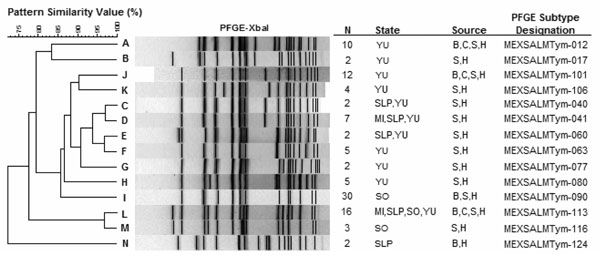Volume 14, Number 3—March 2008
Research
Integrated Food Chain Surveillance System for Salmonella spp. in Mexico1
Figure 2

Figure 2. Selected pulsed-field gel electrophoresis (PFGE) clusters that represent 102 strains of Salmonella Typhimurium and shared indistinguishable PFGE patterns among humans (H), chicken meat and intestine (C), pork meat and swine intestine (P), and beef meat and cattle intestine (B). Several clusters (C,D, E, and L) were present in more than one state. MI, Michoacan; SLP, San Luis Potosi; SO, Sonora; YU, Yucatan. An expanded version of this figure containing the complete set of PFGE patterns is available from http://www.cdc.gov/EID/content/14/3/429-G2.htm.
1Presented in part at the International Association for Food Protection 93rd Annual Meeting, August 13–16, 2006, Calgary, Alberta, Canada.
Page created: July 07, 2010
Page updated: July 07, 2010
Page reviewed: July 07, 2010
The conclusions, findings, and opinions expressed by authors contributing to this journal do not necessarily reflect the official position of the U.S. Department of Health and Human Services, the Public Health Service, the Centers for Disease Control and Prevention, or the authors' affiliated institutions. Use of trade names is for identification only and does not imply endorsement by any of the groups named above.